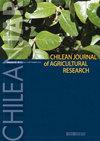近红外光谱法预测热带禾本科植物理化成分
IF 1.5
4区 农林科学
Q2 AGRICULTURE, MULTIDISCIPLINARY
引用次数: 0
摘要
使用近红外光谱(NIRS)作为饲料成分研究中常用的技术的替代方法需要探索。目的是建立预测热带禾草Brachiaria brizantha (Hochst.)理化成分的校准曲线。A.里奇。Stapf本文章由计算机程序翻译,如有差异,请以英文原文为准。
Prediction of the physical-chemical composition of tropical grasses through NIR spectroscopy
The use of near infrared spectroscopy (NIRS) as an alternative to the techniques commonly employed in the study of forage composition needs to be explored. The objective was to construct calibration curves to predict the physical-chemical composition of tropical grasses (Brachiaria brizantha (Hochst. ex A. Rich.) Stapf âMaranduâ, âPiatãâ; B. decumbens Stapf, Panicum maximum Jacq. âColoniãoâ), by NIRS and compare two multivariate regression method. Forage samples were analyzed for crude protein (CP), acid detergent fiber (ADF), neutral detergent fiber (NDF), ash, ether extract (EE), lignin, and moisture. The values obtained by the Official Methods of Analysis of Association of Official Agricultural Chemists (AOAC) were reference values for the creation of multivariate calibration models. The samples were scanned on the NIRS. The multivariate calibration models were created by the partial least squares (PLS) method and by the multiple linear regression (MLR) method. The predictive capacity of the models was evaluated by the correlation coefficient (R) and parameters of the mean squared deviation (RMSE). When the MLR was used, only the prediction model of ash (R = 0.82) of the P. maximum, EE (R = 0.87) and moisture (R = 0.90) of âPiatãâ showed approximate predictive capacity, for the other components R indicated good prediction. After the validation of the models developed by the PLS regression method, the CP (0.78-0.91), NDF (0.88-0.95), lignin (0.85-0.91), and moisture (0.79-0.96) predictions presented good results. The NIRS technique can be used to determine the physical-chemical composition of tropical grasses. The MLR multivariate regression method as well as PLS can be used to predict the physical-chemical composition of tropical grasses.
求助全文
通过发布文献求助,成功后即可免费获取论文全文。
去求助
来源期刊

Chilean Journal of Agricultural Research
AGRICULTURE, MULTIDISCIPLINARY-AGRONOMY
CiteScore
3.10
自引率
11.80%
发文量
60
审稿时长
6-12 weeks
期刊介绍:
ChileanJAR publishes original Research Articles, Scientific Notes and Reviews of agriculture, multidisciplinary and agronomy: plant production, plant protection, genetic resources and biotechnology, water management, soil sciences, environment, agricultural economics, and animal production (focused in ruminant feeding). The editorial process is a double-blind peer reviewing, Editorial Office checks format, composition, and completeness, which is a requirement to continue the editorial process. Editorial Committee and Reviewers evaluate relevance and scientific merit of manuscript.
 求助内容:
求助内容: 应助结果提醒方式:
应助结果提醒方式:


